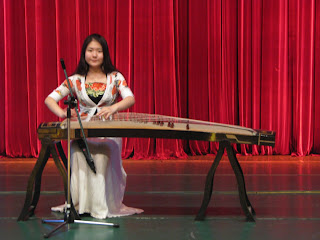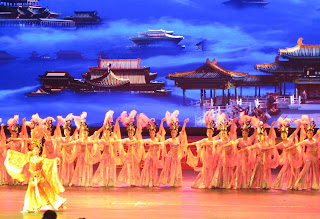Emperor Qin Shi Huang, the first
Emperor of China, spent 36 years preparing for his funeral. Employing
700,000 slaves, he constructed thousands of “terracotta soldiers,”
an army of life-sized pottery men, horses and chariots intended to
serve and protect him through the afterlife. For company, he had
3,000 concubines (wives) buried alive with his body and to make sure
none of his enemies could discover his tomb, he had all 700,000
slaves buried along with him. Standing at the edge of pit one where
6,000 terracotta soldiers have been unearthed, the enormity of the
event leaves you wondering what would drive a man to conceive such an
undertaking.
The day began with a spectacular view
of a waking Xi'an form our eighth floor hotel room. One entire wall
was made up of picture windows with a view of the street below. The
following images are from our room and along the route to our first
stop, a jade factory outlet.
Xi'an citizens primary means of
transportation is the city bus, there were literally hundreds running
constantly back to back.
Like Beijing, row upon row of apartment
complexes were home to the residents of Xi'an.
For power, needs, this nuclear reactor
was nestled quietly among the apartment buildings.
I was told China did not permit
motorcycles, and while I saw very few, this is evidence of their
existence!
We even saw a few tire dealers along
our way.
Our first stop was a jade factory
outlet. Jade is the pride of China, even more precious than silk or
pearls. Prices ranged from thousands of dollars to a few yuan, but of
course, everything is negotiable!
From the jade outlet we made our way to
the “new city,” a beautiful green-space under the watchful
protection of a pagoda (Buddhist temple). We had some free time to
stroll and shop for souvenirs among the local street vendors. Here's
me under the pagoda.
Despite rising divorce rates, the
family unit remains at the core of China's social structure, as this
sculpture portrays.
The Giant Goose Pagoda.
A little shopping for souvenirs.
I couldn't resist a picture of this cute little guy!
Our next stop, the outskirts of Xi'an
where will find the famous Terracotta warriors. Just outside the
archaeological site, we ate the best meal so far, featuring a variety
of vegetables and noodles. After a short wait in line highlighted by
an altercation with a Japanese group, we were inside the museum
standing on the brink of history. This make-believe army was created
and entombed in 210 BC. We are overlooking 6,000 soldiers of what is
believed to be part of a force totaling more than 32,000. Each figure
is completely unique from the rest, all sporting their own facial
expression and posture. What we see today are colorless from time but
when created, they were all individually hand painted in exact
detail. These are only a few of the pictures I took and they don't do
justice to the immenseness of the dig, you need to see it for
yourself. These first pictures are from pit one.
Pit two was much smaller than pit one
and was thought to hold the command center for the army. The first
picture is what the site looks like when first opened, the soldiers
shattered and in thousands of pieces. The second picture is after 8
years of intricate reconstruction. The third picture is of a set of
horses and driver (the chariot, made from wood, has long since faded
back to the earth).
The next picture is from pit 3. The
government of China elected to wait another 50 years before starting
this dig, to see if technology can advance to a point where the
coloring can be protected. The long indentation in the earth is from
the ceiling over the army caving in over the years.
This last picture is of a bronze horse
found in the Emperor's tomb that was pulling a model of the funeral
carriage that brought him to his final resting place.
From the Terracotta Museum we made our
way back to Xi'an for our dinner and show. The meal was another big
hit, this time we had a type of ravioli, what the Chinese call
dumplings. The dumplings were served in individual platters of eight
(we were eight at the table), each platter featuring a different
filling, from pork to chicken to shrimp to mushroom. During dinner we
were entertained by a young zither player that was very good. After
dinner, we stayed at the table and were amazed by a spectacular
period dance and music show from the Tang Dynasty.
Here, Lucie has found another friend!
As we close out our day and our visit
to Xi'an we prepare our luggage for the next leg of our journey,
Suzhou – the Venice of China!








































No comments:
Post a Comment